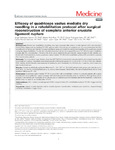Efficacy of quadriceps vastus medialis dry needling in a rehabilitation protocol after surgical reconstruction of complete anterior cruciate ligament rupture

Use este enlace para citar
http://hdl.handle.net/2183/29945
A non ser que se indique outra cousa, a licenza do ítem descríbese como Atribución-CompartirIgual 3.0 España
Coleccións
- Investigación (FEP) [511]
Metadatos
Mostrar o rexistro completo do ítemTítulo
Efficacy of quadriceps vastus medialis dry needling in a rehabilitation protocol after surgical reconstruction of complete anterior cruciate ligament ruptureAutor(es)
Data
2017-04Cita bibliográfica
Velázquez-Saornil, Jorge PT, PhDa; Ruíz-Ruíz, Beatriz PT, PhDa; Rodríguez-Sanz, David PT, DP, PhD*,a; Romero-Morales, Carlos PT, PhDa; López-López, Daniel DP, PhDb; Calvo-Lobo, Cesar PT, PhDc Efficacy of quadriceps vastus medialis dry needling in a rehabilitation protocol after surgical reconstruction of complete anterior cruciate ligament rupture, Medicine: April 2017 - Volume 96 - Issue 17 - p e6726 doi: 10.1097/MD.0000000000006726
Resumo
[Abstract] Background:
Several new rehabilitation modalities have been proposed after anterior cruciate ligament (ACL) reconstruction. Among these, trigger point dry needling (TrP-DN) might be useful in the treatment of myofascial pain syndrome associated with ACL reconstruction to reduce pain intensity, increase knee flexion range and modify the mechanical properties of the quadriceps muscle during late-stage rehabilitation. To date, this is the first randomized clinical trial to support the use of TrP-DN in the early rehabilitation process after ACL reconstruction. The aim of this study was to determine the pain intensity, range of motion (ROM), stability, and functionality improvements by adding quadriceps vastus medialis TrP-DN to the rehabilitation protocol (Rh) provided to subacute ACL reconstructed patients.
Methods:
This randomized, single-blinded, clinical trial (NCT02699411) included 44 subacute patients with surgical reconstruction of complete ACL rupture. The patients were randomized into 2 intervention groups: Rh (n = 22) or Rh + TrP-DN (n = 22). Pain intensity, ROM, stability, and functionality were measured at baseline (A0) and immediately (A1), 24 hours (A2), 1 week (A3), and 5 weeks (A4) after the first treatment.
Results:
Comparing statistically significant differences (P ≤ .001; Eta2 = 0.198–0.360) between both groups, pain intensity (at A1), ROM (at A1, A2, and A3), and functionality (at A2, A3, and A4) were increased. Nevertheless, the rest of measurements did not show significant differences (P > .05).
Conclusion:
Quadriceps vastus medialis TrP-DN in conjunction with a rehabilitation protocol in subacute patients with surgical reconstruction of complete ACL rupture increases ROM (short-term) and functionality (short- to mid-term). Although there was an increase in pain intensity with the addition of TrP-DN, this was not detected beyond immediately after the first treatment. Furthermore, stability does not seem to be modified after TrP-DN.
Palabras chave
Anterior cruciate ligament
Ligamento cruzado anterior
Anterior cruciate ligament reconstruction
Reconstrucción del ligamento cruzado anterior
Myofascial pain syndrome
Síndrome de dolor miofascial
Physical therapy modalities
Modalidades de terapia física
Rehabilitation
Rehabilitación
Trigger points
Puntos de activación
Ligamento cruzado anterior
Anterior cruciate ligament reconstruction
Reconstrucción del ligamento cruzado anterior
Myofascial pain syndrome
Síndrome de dolor miofascial
Physical therapy modalities
Modalidades de terapia física
Rehabilitation
Rehabilitación
Trigger points
Puntos de activación
Versión do editor
Dereitos
Atribución-CompartirIgual 3.0 España
Ítems relacionados
Mostrando ítems relacionados por Título, autor ou materia.
-
Los Músculos Isquiosurales y su Capacidad Profiláctica sobre la Translación Tibial Anterior en Lesión de Ligamento Cruzado Anterior: Una Revisión Sistemática
Saavedra-García, Miguel A.; Mourino Cabaleiro, Alberto; Vila Suárez, Mª Helena; Fernández Romero, Juan J. (Sociedad Chilena de Anatomía, 2023-08)[Resumen]: La ruptura de ligamento cruzado anterior (LCA) es la lesión de rodilla más común que se trata de una reconstruc- ción quirúrgica. El objetivo principal de esta revisión fue analizar la importancia de la función ... -
Association between anterior talofibular ligament injury and ankle tendon, ligament, and joint conditions revealed by magnetic resonance imaging
Casado-Hernández, Israel; Becerro-de-Bengoa-Vallejo, Ricardo; Losa Iglesias, Marta Elena; Santiago-Nuño, Fernando; Mazoteras-Pardo, Victoria; López-López, Daniel; Rodríguez Sanz, David; Calvo-Lobo, César (2021)[Abstract] Background: The lateral ankle ligament complex is the most frequently injured ligament secondary to strong ankle inversion movement during lateral ankle sprains (LAS). Among these injuries, anterior talofibular ... -
Influencia de lesiones asociadas en la intervención de un protocolo de fuerza y propiocepción en cirugía de ligamento cruzado anterior
Velázquez Saornil, Jorge; Calvo-Lobo, César; Ruiz Ruiz, Beatriz (Universidade da Coruña, 2016)[Resumen] Objetivo: Observar si las lesiones asociadas a una rotura completa de ligamento cruzado anterior (LCA) en pacientes intervenidos con cirugía de reconstrucción influye en la mejoría de la movilidad articular (escala ...






